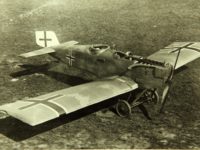The Junkers CL.I was one of the few aircraft in the German Empire that were covered almost entirely with metal instead of wood and thus protected the pilot and the observer much better against fire.
Development and construction:
With the outbreak of the First World War, the production of Junkers & Co. for civilian goods came almost completely to a standstill and mainly field kitchens were produced for the German army.
In 1915, the designer Hugo Junkers developed the world's first all-metal aircraft, the J1. In the following years, several successor models were developed, but did not go beyond the status of the prototype.
It was not until the development and production of the Junker J.I ground combat aircraft that a basis was created that led to the development of the CL.I in early 1918.
Full metal cladding protected the pilot and observer from enemy fire, as in previous models, and enabled them to attack more effective targets on the ground. For these attacks either the assembled machine guns were used or bombs and hand grenades, which were attached to small containers on the observation stand.
Use in the First World War:
In the summer of 1918 began with the production of aircraft. For the first series 43 machines were initially planned, but by the end of the war only six could be completed.
In contrast to the Junkers J.I the CL.I was no longer used at the front, but by Freikorps in Finland and the Baltic States in the fight against the Communists until the year 1919.
Technical specifications:
| Designation: | Junkers CL.I |
| Country: | German Empire |
| Typ: | Ground attack aircraft |
| Length: | 7,9 meters |
| Span: | 12,05 meters |
| Height: | 2,65 meters |
| Mass: | 735kg empty |
| Crew: | Max. 2 |
| Engine: | Water cooled inline engine Mercedes D.IIIaü 180hp |
| Maximum speed: | 169 km/h |
| Reach: | 380 kilometers |
| Armament: | 2 x machine guns 7,92 mm Parabellum, 1 x 7,92 mm 08/15 Spandau machine gun and up to 50Kg bombs |
You can find the right literature here:
Fokker Dr I Aces of World War 1 (Aircraft of the Aces)
Undoubtedly the most famous fighter type to see service on either side during World War 1, the Fokker Dr I was a revelation when it entered service on the western front in 1917. Manfred von Richthofens JG 1 circus was the first Jasta to completely re-equip with the new fighter, and in the skilled hands of its numerous aces the Dr I proved a formidable opponent. The Dr I remained in service on the Western Front until replaced by the superior Fokker D VII in May 1918. Just weeks prior to that, however, Germanys leading ace, the great Red Baron, had been killed at the controls of a Dr I.
Friedrichshafen Aircraft of WWI: A Centennial Perspective on Great War Airplanes (Great War Aviation) (Volume 21)

Friedrichshafen Aircraft of WWI: A Centennial Perspective on Great War Airplanes (Great War Aviation) (Volume 21) Paperback – February 16, 2016
This book describes and illustrates the development of Friedrichshafen aircraft of WWI with text, 540 photos, 18 in color, 37 color profiles, production quantities and serial numbers of aircraft, and aircraft dimensions and performance specifications. In addition, there are 26 official SVK drawings and 11 aircraft are illustrated in scale drawings to 1/48 (4) or 1/72 (7) scales. The book has 312 pages and is of interest to aviation historians, enthusiasts, and modelers alike.
German and Austro-Hungarian Aircraft Manufacturers 1908-1918
Much has been written about the British aircraft of the First World War, but little has surfaced about the aircraft of the Axis powers, Germany and Austria. Here, Terry C. Treadwell tells the story of the aircraft from companies such as Fokker, builder of the famous triplane, as fl own by Baron von Richthofen's Flying Circus, AEG, Albatros, Junkers and Hansa. From reconnaissance aircraft to state-of-the-art bombers that could reach London, this is the definitive guide to aircraft of the Axis powers during the First World War. The aircraft are explained in detail and a history of each company is provided, making this an excellent source book for aircraft enthusiasts, model makers and those interested in the air war over the trenches of France and Belgium, as well as further afield in the Italian campaign.
The Zeppelin in Combat: A History of the German Naval Airship Division
The standard reference now revised and expanded. Dr. Robinson has opened up his vast photo archives to enhance this new edition of his classic work. Much of the new photographic material is published here for the first time.
This post is also available in:
 Deutsch (German)
Deutsch (German)  Français (French)
Français (French)  Italiano (Italian)
Italiano (Italian)  简体中文 (Chinese (Simplified))
简体中文 (Chinese (Simplified))  Русский (Russian)
Русский (Russian)  Español (Spanish)
Español (Spanish)  العربية (Arabic)
العربية (Arabic)















